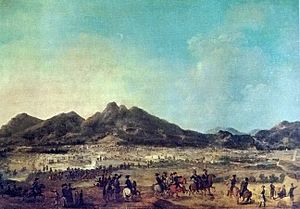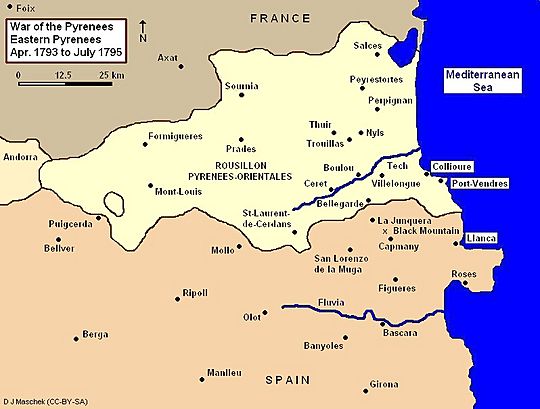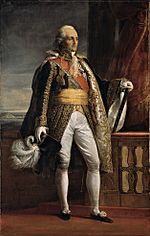War of the Pyrenees facts for kids
Quick facts for kids War of the Pyrenees |
|||||||||
|---|---|---|---|---|---|---|---|---|---|
| Part of the War of the First Coalition | |||||||||
 Battle of Boulou |
|||||||||
|
|||||||||
| Belligerents | |||||||||
| Commanders and leaders | |||||||||
| Units involved | |||||||||
| Strength | |||||||||
The War of the Pyrenees, also known as the War of Roussillon or War of the Convention, was a conflict fought in the Pyrenees mountains. It was part of a larger war called the First Coalition against the First French Republic. This war involved Revolutionary France fighting against the kingdoms of Spain and Portugal. It lasted from March 1793 to July 1795.
The fighting happened in the eastern and western parts of the Pyrenees mountains. There were also battles at the French port of Toulon and at sea. In 1793, a Spanish army entered Roussillon in the eastern Pyrenees. They stayed on French land until April 1794. The French Revolutionary Army then pushed the Spanish Army back into Catalonia. The French won a big victory in November 1794. After February 1795, the war in the eastern Pyrenees became a standstill. In the western Pyrenees, the French started winning in 1794. By 1795, the French army controlled part of northeast Spain.
This war was very harsh. The French government group, called the Committee of Public Safety, ordered that all French royalist prisoners be put to death. Also, French generals who lost battles or upset the government representatives often faced prison or execution. Commanders of the Army of the Eastern Pyrenees were especially unlucky.
Contents
Why the War Started
On January 21, 1793, the French government, known as the National Convention, put their king, Louis XVI, to death using a guillotine. This made other kings in Europe very angry. France was already fighting against the Habsburg monarchy, the Kingdom of Prussia, and the Kingdom of Sardinia.
After winning the Battle of Jemappes, the French army took over the Austrian Netherlands. Feeling confident, the French government decided to make this area (which is modern Belgium) part of France. This caused a diplomatic break with Great Britain. On February 1, France declared war on Britain and the Dutch Republic. Then, on March 7, France declared war on Spain, which used to be its ally.
The Siege of Toulon
Spanish forces helped in the Siege of Toulon. This siege lasted from September 18 to December 18, 1793. The French army was led by Jacques François Dugommier. The combined British and Spanish defenders were commanded by Admirals Juan de Lángara and Federico Gravina, and General Charles O'Hara.
The Allied forces left the port after a young artillery officer, Napoleon Bonaparte, managed to aim cannons at the ships. The French navy lost 14 large warships that were burned and 15 more that were captured. About 2,000 French soldiers were hurt or killed. The Allied forces had twice as many losses. After the battle, many French royalists who had been captured were killed by the victors.
A naval battle happened on February 14, 1795, in the Gulf of Roses. This was a defeat for the French navy.
Fighting in the Eastern Pyrenees
When the war began, King Charles IV of Spain put Captain General Antonio Ricardos in charge of the Army of Catalonia in the eastern Pyrenees. Ricardos invaded the Cerdagne area and captured Saint-Laurent-de-Cerdans on April 17, 1793. Three days later, he defeated a French force at Céret near the Tech River. On April 30, the French government divided its army into the Army of the Eastern Pyrenees and the Army of the Western Pyrenees.
In the Battle of Mas Deu on May 19, 1793, Ricardos defeated Louis-Charles de Flers. This allowed the Spanish to surround Fort de Bellegarde on May 23. The Siege of Bellegarde ended when the French soldiers inside surrendered on June 24. During the Battle of Perpignan on July 17, de Flers pushed back the Spanish, even though the French had more losses. On August 28, Luc Siméon Auguste Dagobert defeated a Spanish force led by Manuel la Peña at Puigcerdà in the Cerdagne.
In September, Ricardos sent two groups of soldiers to cut off the fortress of Perpignan. However, Eustache Charles d'Aoust gathered the French forces to win the Battle of Peyrestortes on September 17. This was the farthest the Spanish got into Roussillon. Five days later, Ricardos defeated Dagobert at the Battle of Truillas before falling back to the Tech Valley. Ricardos pushed back d'Aoust at Le Boulou on October 3. The Battle of the Tech (Pla del Rei) from October 13–15 saw the Spanish stop attacks from Louis Marie Turreau. A group of 5,000 Portuguese soldiers, led by John Forbes, joined Ricardos. They helped defeat d'Aoust at the Battle of Villelongue-dels-Monts on December 7. At the Battle of Collioure, Gregorio García de la Cuesta captured the ports of Collioure and Port-Vendres from the French on December 20.
Ricardos died on March 6, 1794, and Spanish success seemed to die with him. Captain General Alejandro O'Reilly died ten days after Ricardos. So, Luis Firmin de Carvajal, Conde de la Union was chosen to lead the Army of Catalonia instead. The Army of the Eastern Pyrenees also got a new commander, Jacques François Dugommier. At the Battle of Boulou, from April 29 to May 1, Dugommier pushed de la Union's army south across the border. The Spanish had to leave behind all their cannons and supplies.
Collioure fell to the French in late May. Eugenio Navarro's 7,000 Spanish soldiers became prisoners. The French royalist defenders escaped in fishing boats before surrendering to avoid being put to death. Dugommier started blocking Bellegarde on May 5. The Battle of La Junquera on June 7 did not have a clear winner. At the Battle of San-Lorenzo de la Muga (Sant Llorenç de la Muga) on August 13, Pierre Augereau stopped a Spanish attempt to help Bellegarde. The fortress fell on September 17 after the Spanish soldiers inside ran out of food. From November 17 to 20, the important Battle of the Black Mountain took place. Both Dugommier and de la Union were killed in this battle. Dominique-Catherine de Pérignon took command of the French and led them to victory. Figueres and its Sant Ferran Fortress quickly fell to the French, and 9,000 Spanish soldiers were captured.
Pierre François Sauret successfully ended the Siege of Roses on February 4, 1795. Pérignon was replaced as army commander by Barthélemy Louis Joseph Schérer. On June 14, 1795, Schérer was defeated near the Fluvià River by José de Urrutia y de las Casas at the Battle of Bascara. After peace was signed, but before the news reached the fighting, Cuesta took back Puigcerdà and Bellver from the French on July 26 and 27.
Fighting in the Western Pyrenees
A few small fights happened in 1793. These included actions by Bon-Adrien Jeannot de Moncey's soldiers at Chateau-Pignon on June 6, Aldudes in June, and Saint-Jean-de-Luz on July 23.
On February 5, 1794, at the Battle of Sans Culottes Camp, the French successfully defended a strong position on a hilltop near Hendaye. They fought against 13,000 Spanish soldiers led by José Urrutia y de las Casas. The Spanish had 335 soldiers killed or wounded, and the French had 235 losses. On June 3, a French group of 2,300 soldiers captured the Casa Fuerte position at Izpegi Pass (Col d'Ispeguy). The 1,000 defenders, including Spanish and French royalist soldiers, lost 94 killed and wounded, and 307 were captured. The French losses were small. On the same day, Jacques Lefranc's 2,000 French soldiers took the Izpegi Ridge.
On March 3, 1794, the nearby villages of Sara, Itxassou, Ascain, and nine other Basque villages were declared "dishonorable" by the French government. This happened after 74 young people from these villages ran away south to the Spanish Basque region instead of watching the border for the French army. All people in these villages, from ages 3 to 88, were treated like criminals. They were put into carts and taken to the Landes of Gascony. Men and women were separated, and their valuable things were taken or burned. Several thousand people may have been deported. In five months, about 1,600 of them died, with 600 from Sara alone. Many survivors were able to return home a few years later.
On June 23, Captain General Don Ventura Caro, with 8,000 foot soldiers and 500 horse soldiers and cannons, tried to remove a French force from a strong position on Mont Calvaire. He was not successful. The Spanish had 500 killed and wounded, and 34 were captured. The French reported 30 killed and 200 wounded. On July 10, Antoine Digonet, with 4,000 troops, defeated the Spanish and French royalist soldiers defending Mount Argintzu. Spanish losses were 314, and the French royalist commander was badly hurt. The French Republicans put 49 French royalist prisoners to death.
On July 23, the Army of the Western Pyrenees attacked Spanish strongholds. Jacques Léonard Muller was the army commander, but Moncey was in charge of the fighting during the Battle of the Baztan Valley. In battles near Elizondo and Doneztebe (Santesteban), Moncey defeated the Spanish defenses. The French then followed the Bidasoa river north in late July. They took the heights of San Marcial and the town of Hondarribia (Fuenterrabia) near the coast. In this operation, Moncey captured Don Vicente de los Reyes, 2,000 Spanish soldiers, and 300 cannons on August 1. Moncey then captured San Sebastián without a fight on August 3. Another 1,700 Spanish soldiers and 90 cannons were taken by the French. Soon after, the French also captured the town of Tolosa. Moncey was quickly promoted to army commander.
On August 14, 1794, the General Assembly of Gipuzkoa met in the coastal town of Getaria. They had the support of the business people from San Sebastián. They then had talks with French army officials. The council wanted to separate from Spain, keep their special laws, and become loyal to France. They also wanted to practice Catholicism freely and set rules for managing war situations. However, peace talks were already happening for the Peace of Basel. So, the French army's representatives refused to accept these demands. The Gipuzkoan representatives were put in prison or sent away.
Because of this, another meeting was held in Mondragón on September 13. This time, the regional representatives decided to support Ferdinand VII of Spain. They formed their own local army against the French. However, soon after, the more diplomatic Moncey brought back the local government of Gipuzkoa. The news of what happened in Getaria spread quickly to Madrid. It made Spanish leaders and the press very angry. They criticized the Basque province and its people. Also, after being imprisoned, the Gipuzkoan representatives were hunted down by Spanish authorities. They were tried for treason and "unpatriotic behavior."
From October 15 to 17, Moncey started a large attack from the Baztan Valley and the Roncevaux Pass south toward Pamplona. The Battle of Orbaitzeta included fights at Mezkiritz (Mezquiriz), Orbaitzeta, Lekunberri, and Villanueva (Hiriberri). The 46,000 French soldiers pushed back 13,000 Spanish troops led by Pedro Téllez-Girón, 9th Duke of Osuna. The Spanish lost 4,000 soldiers and 50 cannons. French losses are not known. The places where weapons were made at Orbaitzeta and Eugi, and the Spanish navy's wood storage at Irati, were taken by the French. However, winter weather and disease caused the fighting to stop for the year. A final clash happened at Bergara on November 7. The French caused losses of 150 killed and 200 captured soldiers, and one cannon, from a 4,000-man group led by Cayetano Pignatelli, 3rd Marquis of Rubí. The town was robbed, but a small group of local soldiers, led by Gabriel Mendizabal, managed to take it back.
During the winter, Moncey reorganized his army. He had lost 3,000 soldiers to disease. He finally got the equipment needed for a siege. In June 1795, 12,000 more soldiers arrived from the Army of the West. Moncey's attack began on June 28 and soon pushed back Crespo's Spanish forces. Vitoria fell to the French on July 17, and Bilbao two days later. When news of the Peace of Basel arrived in early August, Moncey had crossed the Ebro River. He was getting ready to surround Pamplona.
How the War Ended
The Peace of Basel officially ended the war on July 22, 1795. Moncey was very close to Pamplona. The Basque people were worried about losing their self-government. Spanish Prime Minister Manuel Godoy was afraid that the still-independent Basque region might switch its loyalty to France and leave Spain. In the peace treaty, Spain gave up the eastern two-thirds of the island of Hispaniola to France. In return, Spain kept Gipuzkoa.
Also, because Moncey and a French government group asked for it, an extra part was added to the treaty. This part promised that the Spanish Basques, especially those from Gipuzkoa who had shown support for the French, would not be punished by Spanish authorities. This was agreed upon. However, despite this promise, at least the city council of San Sebastián was arrested and put on trial in Pamplona starting in February 1796.
Under the Second Treaty of San Ildefonso on August 19, 1796, France and Spain formed an alliance. However, peace was not made with the Portuguese, who remained part of the group fighting against France.
Sources
- Chandler, David, ed. Napoleon's Marshals. New York: Macmillan, 1987. ISBN: 0-02-905930-5
- Beckett, Ian F. W. "Moncey: An Honest Man".
- Horward, Donald D. "Lannes: Roland of the Army".
- Ostermann, Georges. "Pérignon: The Unknown Marshal".
- Durant, Will and Durant, Ariel. The Age of Napoleon. New York: MJF Books, 1975. ISBN: 1-56731-022-2
- Smith, Digby. The Napoleonic Wars Data Book. London: Greenhill, 1998. ISBN: 1-85367-276-9
Diario de las operaciones del ejército español que entró en Francia por el Rosellón, Biblioteca Nacional de España, MSS/1276, 1001158748.
See also
 In Spanish: Guerra del Rosellón para niños
In Spanish: Guerra del Rosellón para niños




